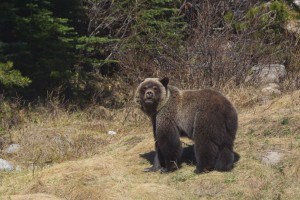
Parks Canada has already captured and collared six grizzly bears this season and hopes to collar another four as part of a three-year study of the bear’s habitat use in Jasper National Park.
Working with the Foothill Research Institute (FRI), a concurrent study will track the grizzly bear population in an area adjacent to the park to compare the impact humans have on the bear’s habitat.
“We want to understand how bears are using the landscape and if they are using it the same way they did 15 years ago,” said Gordon Stenhouse, research scientist and grizzly bear program leader for FRI.
He said researchers first started collecting data about grizzly bears in 1999 and with this study researchers will be able to compare the bears’ health, population trends and habitat use patterns over the past decade and a half.
“In the past 15 years the landscape outside the national park has changed rather dramatically with forestry, mining and oil and gas, but in the national park itself there hasn’t been much change other than maybe the Syncline Ridge fire in 2003,” he said.
“We want to evaluate how the bear populations have responded to those changes.”
Essentially, JNP is acting as a control for the study, because there is less human activity in the park.
“We’re hoping that the data the bears give us will really help us manage the way bears and humans share the park,” said Mark Bradley, a wildlife biologist with Parks.
In 2002, Alberta’s Endangered Species Conservation Committee recommend grizzly bears be listed as “threatened” under Alberta’s Wildlife Act, however it was not listed until 2010. In 2002, the Committee on the Status of Endangered Wildlife in Canada (COSEWIC) recommended the animal as a “species of special concern,” but was also rejected by the federal government under the Species of Risk Act (SARA).
COSEWIC tried again in 2012, only to be rejected a second time.
Collared with GPS satellite radios, the bears will be tracked as they move throughout the park, revealing the areas of the park the bears use and areas they tend to avoid or don’t use at all.
“The collars take an accurate location every hour and send that information to a satellite that gets relayed to us,” said Bradley.
To capture the 20 bears needed for the study (10 inside and 10 outside the park), Parks and FRI are using a combination of culvert traps and darts from a helicopter. It is estimated there are between 100 to 120 grizzly bears in the park.
To date, four males and two females have been captured, with the largest weighing about 275 pounds.
“By grizzly standards that’s not very big,” said Bradley. “The same bear that’s 275 pounds now might be well into the upper 300s by the end of the summer, because they’ve just come out of hibernation.”
The collars are equipped with remote release mechanisms to eliminate the need to recapture the bears to remove the collars.
Several areas in the park were temporarily closed while the traps were in place, but have since reopened, except for one area on Highway 93 where a trap still remains, said Bradley. He declined to specify where the trap is located because he doesn’t want people to go looking for it.
The helicopter work will be completed in the next three weeks, as the snow melts in the higher elevations.
Paul Clarke
[email protected]
